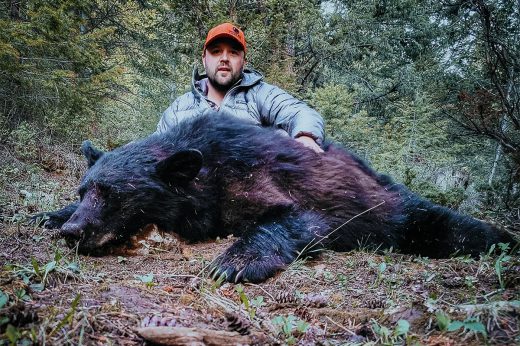If the black bear population in Alberta, Canada, isn’t managed, the animals can destroy a farmer’s fields in the spring with surprising speed. They can also do significant damage to the young spring progeny of ungulates in a given area if there are too many bears. So, those farmers invite hunters to help control the population to preserve it, their crops, and game animal populations and to experience an amazing Alberta bear hunt.
This latest video series from Free Range American takes you inside a northern Alberta bear hunt with a group of hunters whose primary goal is to help outfitters John and Jenn Rivet manage the local black bear population one broadhead at a time.
And since the forest is so dense and shooting opportunities come well under 100 yards – often inside 50 yards — bear baiting is the tactic of choice in Alberta.
“Bear baiting started in Alberta in the mid-80s when the government realized there were bear problems,” John explains. “There were farmers that would plant a crop, just 160-acre field of oats, and have 30 to 40 bears in it, just destroying it by rolling in it. The field would look like a steamroller went by.
“So cougars, wolves, bears, a farmer can shoot as many as he wants on his own land to protect his property. But it’s way better to have hunters coming in to hunt a couple of bears and manage that population.

“It saves a lot of moose, saves a lot of deer, saves a lot of elk that they predate on in the spring when they are giving birth. [Bears] will follow that ungulate, and when one calf or fawn drops, they grab it and go with it.”
On the first day of the hunt, excitement and anticipation thrum through the group like electricity.
“I’m just hoping to get some good bear out here and just shoot straight, honestly. I am so excited,” says Amanda Sheets from Black Rifle Coffee Company.
Lucas O’Hara, the founder and owner of Grizzly Forge Knives, is just as psyched for the first day.
“This is my first archery hunt, and I’m pretty excited about it. The first hunt I ever went on was with my grandfather when I was nine years old, and it was for black bear,” O’Hara says. “It was the first animal I ever killed. It’s pretty cool that it gets to go full circle now, and my first archery hunt gets to be a black bear.”

O’Hara’s first taste of bowhunting is a dramatic one. He spends some up-close-and-personal time with a 3- 4-year-old sow who spends some serious time playing with a beaver head bait.
“It’s pretty freakin’ rad to be that close to a bear,” O’Hara says.
“She’s huffing and puffing. I think she thinks this is her spot,” Jenn whispers by his side. “I don’t think she’s too happy that we’re here, so we’re just going to keep an eye on her just to make sure she behaves like a good little girl.”
O’Hara passes on shooting the young sow, which is one of the beautiful advantages to bear baiting, especially in densely forested areas of Alberta.

“It’s very hard to kill bears because we don’t have a lot of big open areas like Montana or Idaho would have where you can glass a big hillside, find a bear and shoot him with a rifle,” John explains. “Most of Alberta is an arboreal forest where the bears live, so it’s solid bush where you need to put bait to draw them out.
“By doing that, you can really manage them well because you can pick gender. You can be very specific and target a certain animal instead of just seeing a bear and shooting it.”
Meanwhile, Sheets is sitting in another area on a different bait site.
“It’s exciting. It gets your adrenaline going,” she says. “We’re at about a solid 14-yard shot. We’re on the ground today, so we’re pretty close.”

When a mature boar comes in to take the bait, Sheets’ broadhead connects with the animal’s lungs. The bear bucks and runs off.
After dark, the hunters and guides combine efforts to track Amanda’s bear. Thankfully, he left a generous blood trail, and they follow big patches until they find the boar curled up dead approximately 200 yards from where Sheets made her shot.
“I’m obnoxiously lucky,” she says after bringing her bear back to camp.

“These animal rights activists think you just go kill something, but it doesn’t happen that way,” John says.
“Everything is managed. Even in northern Canada, where there are polar bear hunts, those animals are counted by biologists, they’re counted by helicopter, and they figure how many can be harvested to keep a steady population.
“Some would say, ‘Oh, just let Nature take its course.’ But we were put on Earth to manage the Earth, and if we’re managing ungulates, if we’re managing elk, we’re managing moose, we’ve got to manage the predators, also. You can’t just let them run rampant.”
BRCC Alberta Bear Hunt Ep. 2: A Hard-Earned, Last-Light Bear
READ NEXT — Comeback: Canadian Hunting Outfitters in a Post-Covid World










Comments